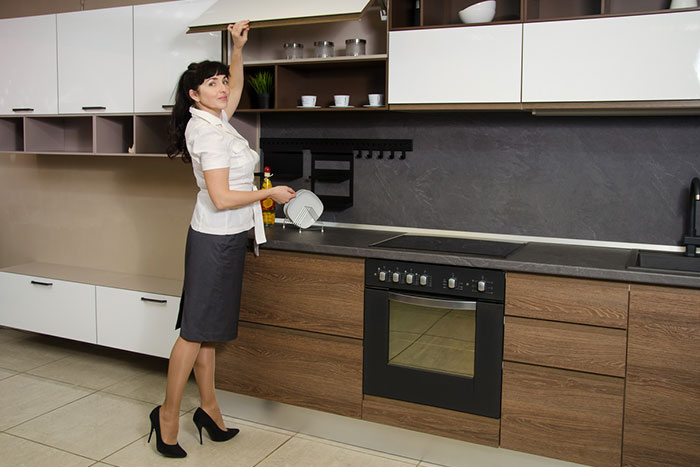
The kitchen really is the heart of the home, so it’s vital to get the design for your new kitchen right. From benchtops to butler’s pantries, splashbacks to sinks, there’s a seemingly endless array of options to consider and decisions to make, and ensuring every detail works together to optimise both functionality and aesthetics can be quite a difficult process. At Duncan Thompson Extensions, we have over 30 years’ experience in delivering exceptional home extensions throughout Melbourne’s eastern and bayside suburbs. We understand the importance of a high quality and well-considered kitchen, and one of the questions we are often asked about is integrated appliances. So, here we will look at what they are, the pros and cons, and whether it might be something you should consider when planning your home extension.
What Are Integrated Kitchen Appliances?
When kitchen appliances such as fridges, freezers, and dishwashers sit inside the kitchen cabinets and are unseen until they are opened for use, this is known as ‘integrated’. This is opposed to having appliances that have the control panels visible or freestanding appliances that can be moved around the room.
Why Choose Integrated Appliances?
Integrating appliances creates a much more streamlined, sleeker aesthetic as they are hidden away behind the cabinetry. Ideal for a modern and minimalist kitchen design with clean lines, they are also particularly effective for smaller kitchens as they make the room look and feel less cluttered, resulting in a feeling of greater spaciousness. Often a distinguishing feature between a custom kitchen and a flat pack, integrated appliances are typically considered luxurious, high-end additions and as such, may add greater value to your home. Potential buyers may assume that money and detailed attention has been spent on other fittings and finishings around the house as well.
Are Integrated Appliances Only for Modern Kitchens?
Whilst integrating fridges, dishwashers, and other kitchen appliances complements a contemporary kitchen design, they can work just as well for traditional and classic kitchens. Here, it is important to choose an appropriate style of cabinetry, such as provincial or shaker style as this will truly create the style of your space. Almost any kitchen design can be enhanced by integrated features, where clutter and appliances are kept completely hidden allowing for a consistent look across the whole room.
Are There Any Downsides?
Often considered a superior choice, they do come at a cost. Integrated appliances generally cost more to purchase and there is a smaller selection in terms of brands and models for you to choose from – your choices are much more limited than freestanding models. Cabinet makers may also charge a little more to allow for the integration, and plumbers or appliance installers may also charge more than standard installation costs. Additionally, it is typically more difficult and therefore more expensive to service integrated appliances due to access issues. They are often more difficult to replace should the need arise.
Space considerations – Most integrated fridges and freezers have a smaller volume than freestanding alternatives, this is because they have a shorter depth so that they can be concealed within the joinery. Finally, when selling or moving you can’t take your appliances with you as they are considered ‘fixtures’ in the home.
Other Things to Consider
Not all appliances can be integrated, in fact, as mentioned above your choices may be limited. When purchasing appliances such as your fridge, freezer, dishwasher and rangehood, make sure you ask the salesperson if they can be fully integrated.
While stoves, cooktops, and ovens cannot be integrated, you should make choices that make these appliances less prominent to complement the overall sleek design. Choose induction cooktops that use a smooth, single surface with the heating elements concealed underneath and digital controls which disappear when not in use.
Similarly, you can never fully conceal a sink, however, by choosing an undermount option in a similar colour to your benchtop, it will be less noticeable.
Another important point is to make sure hardware, such as hinges and door handles, are sturdy and large enough to cope with the extra weight of the fridge/freezer or dishwasher door.
When deciding whether to implement integrated appliances into your kitchen renovation, be sure to consider style, practicality, and value, as well as whether they will complement the design of your kitchen and the aesthetic of your home overall.
Planning A Home Extension? Kew Homeowners Rely on Duncan Thompson Extensions
Passionate about high quality workmanship, innovative design, and sustainability, we are the trusted choice in Melbourne’s East for exceptional single and double storey home renovations. Hawthorn, Kew, Armadale, and homes in suburbs stretching along the stunning Bayside area require a high-end finish and impeccable attention to detail, and that’s exactly what we achieve, from concept to completion. If you are looking for a home renovation builder to bring your vision to life, get in touch with us online now or call (03) 9836 8655 to find out more.
